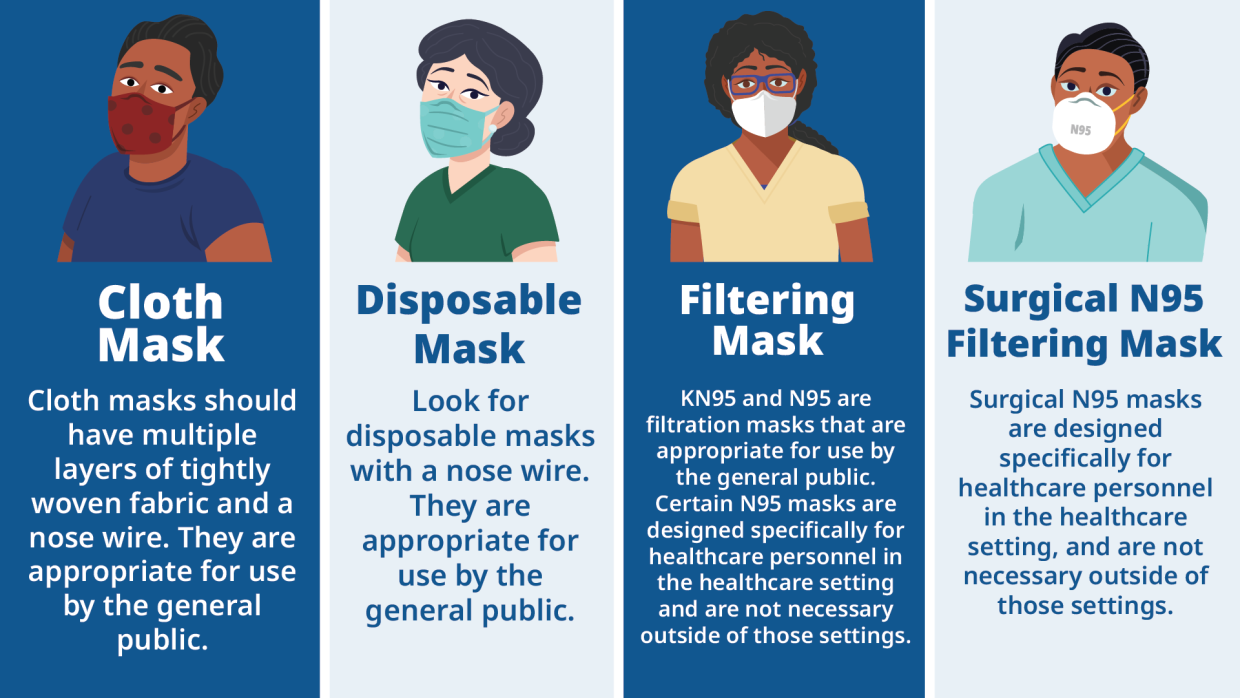Selecting a mask
All masks that are worn properly with a good fit and in good condition offer good protection against COVID-19.
Cloth masks are reusable and may be made from a variety of fabrics. A cloth mask should be made from multiple layers of tightly woven, breathable fabric. When you hold your cloth mask up to a bright light, the fabric should block the light from going through.
Disposable masks (also called surgical or procedural masks) are often used in medical settings, but are widely available to the general public. They are often light blue or white but are sold in a variety of colors.
Some disposable masks have been designed and tested for better performance. To find these masks, look for labeling on the package that says “Meets Workplace Performance/Performance Plus” or “Meets ASTM F3502.” For a list of masks that meet these standards, please see CDC’s webpage.
Filtering masks like N95s and KN95s (also called ‘respirators’) are a type of mask that covers the mouth and nose like other masks.
- KN95 masks are available to the general public. For more information on fit and use of filtering masks, please see the CDC’s webpage.
- N95 masks come in a variety of types, all of which are considered to be filtering masks. Certain N95 masks are designed specifically for healthcare personnel in the healthcare setting.
How to wear a mask: good fit and good condition
Good condition: All masks should be clean, dry and in good condition. Before using your mask, check that there are no tears or loose straps. Make sure your mask is clean and dry. If your mask is washable, be sure to wash regularly. If disposable, throw away the mask when it is dirty, damaged, or difficult to breathe through.
Good fit: No matter which type of mask you wear, make sure it fits well with no gaps. Gaps can be caused if the mask is the wrong size, if it is worn incorrectly or if it is worn with facial hair.
It is important to check that the mask fits snugly over your nose, mouth, and chin.
- All masks should have a nose wire to secure the top of the mask tightly around your nose.
- Make sure no air is flowing from the area near your eyes or from the sides of the mask.
- There should be no openings on the mask such as a vent or valve
- If the ear loops are too long, knot them on each side to make them smaller
- If the mask itself it too big, fold and tuck the unneeded material under the edges. (For instructions, see the video How to Knot and Tuck Your Mask to Improve Fit.)
If it’s comfortable and you can keep a good fit, you can improve protection by wearing two masks – a disposable mask underneath and a cloth mask on top. Filtering masks should not be worn with other masks
See these instructions in other languages
| Language | Word Document | |
|---|---|---|
| English | Selecting and Wearing a Mask | English - accessible |
| Spanish | Selección y uso de una máscara | Spanish-accessible |
| Portuguese | Como selecionar e usar uma máscara | Portuguese - accessible |
| Simplified Chinese | 选择和佩戴口罩 | Simplified Chinese - accessible |
| Traditional Chinese | 選擇和佩戴口罩 | Traditional Chinese - accessible |
| Haitian Creole | Chwazi ak Mete yon Mask | Haitian Creole - accessible |
| Vietnamese | Chọn và Đeo Khẩu Trang | Vietnamese - accessible |
| Albanian | Përzgjedhja dhe mbajtja e një maske | Albanian - accessible |
| Arabic | اختيار القناع وارتداءه | Arabic - accessible |
| Cape Verdean | Skodji i Uza un Maskara | Cape Verdean - accessible |
| Khmer | ការជ្រើសរើសនិងពាក់ម៉ាស់ | Khmer - accessible |
| Russian | Выбор и использование маски | Russian - accessible |
| Somali | Doorashada iyo Xidhashada Wajigashadka | Somali - accessible |
